Child Development: Attachment Theory Research Paper, Sheridan College
VerifiedAdded on 2019/09/20
|8
|1748
|294
Report
AI Summary
This research paper, prepared for Sheridan College, delves into the multifaceted concept of attachment theory and its profound influence on child development. The paper synthesizes multiple sources to define attachment as a fundamental need for secure emotional relationships, emphasizing the importance of caregivers and educators in fostering a nurturing environment. It explores the core principles of attachment theory, highlighting the significance of consistent relationships for children's growth and well-being. The paper examines various attachment patterns, including secure, avoidant, ambivalent, and disorganized attachments, and their respective impacts on a child's emotional, cognitive, and social development. It discusses the implications of these attachment styles in the context of early childhood education, emphasizing the role of educators in building trust and providing a secure base for children. The research also emphasizes the importance of understanding children's emotions and needs to support their healthy development. The conclusion underscores the necessity for parents and educators to provide both physical and emotional support to children, recognizing that secure attachments are crucial for their personality development. The paper references key research studies and articles to support its arguments and offers a comprehensive overview of the subject matter.
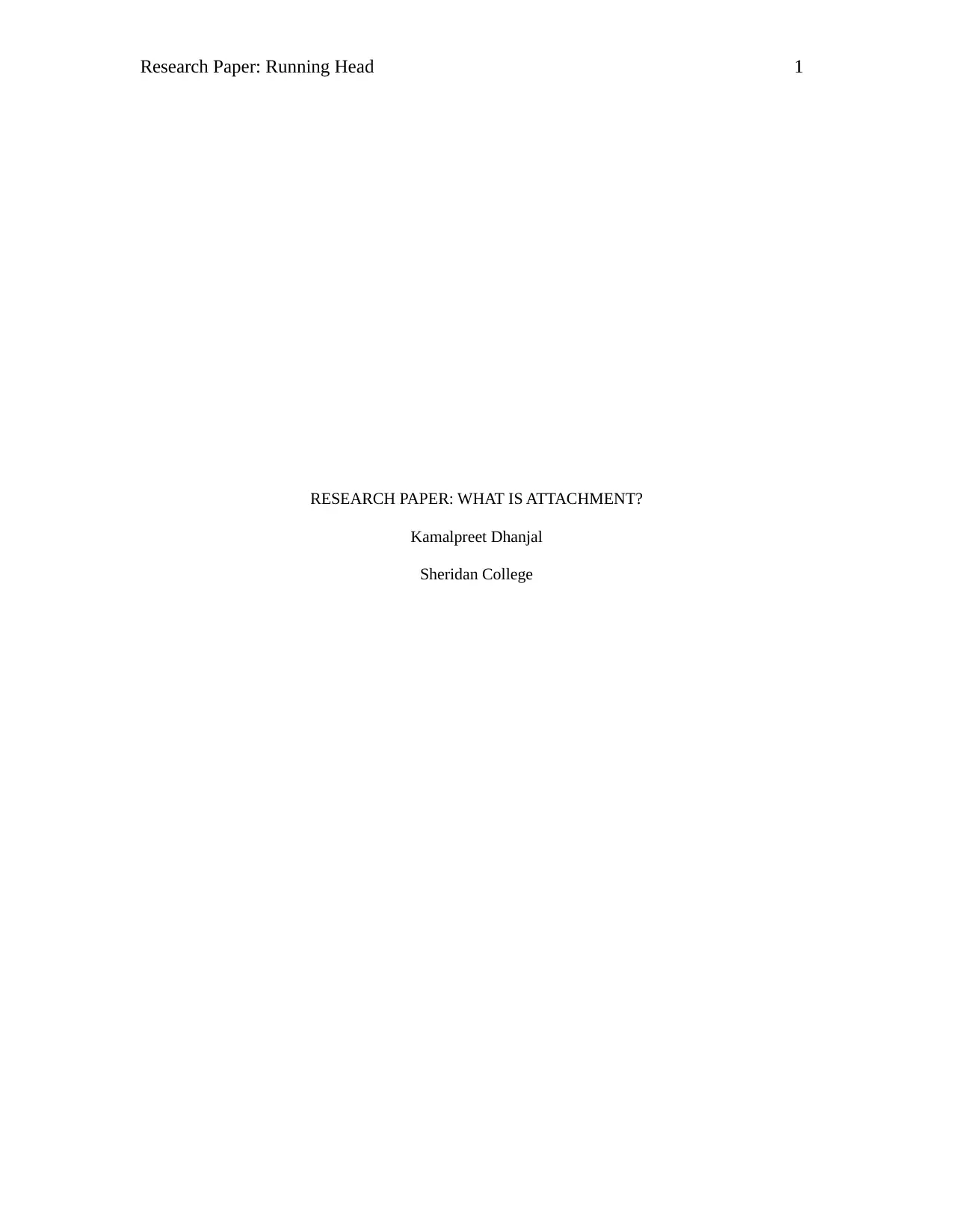
Research Paper: Running Head 1
RESEARCH PAPER: WHAT IS ATTACHMENT?
Kamalpreet Dhanjal
Sheridan College
RESEARCH PAPER: WHAT IS ATTACHMENT?
Kamalpreet Dhanjal
Sheridan College
Paraphrase This Document
Need a fresh take? Get an instant paraphrase of this document with our AI Paraphraser
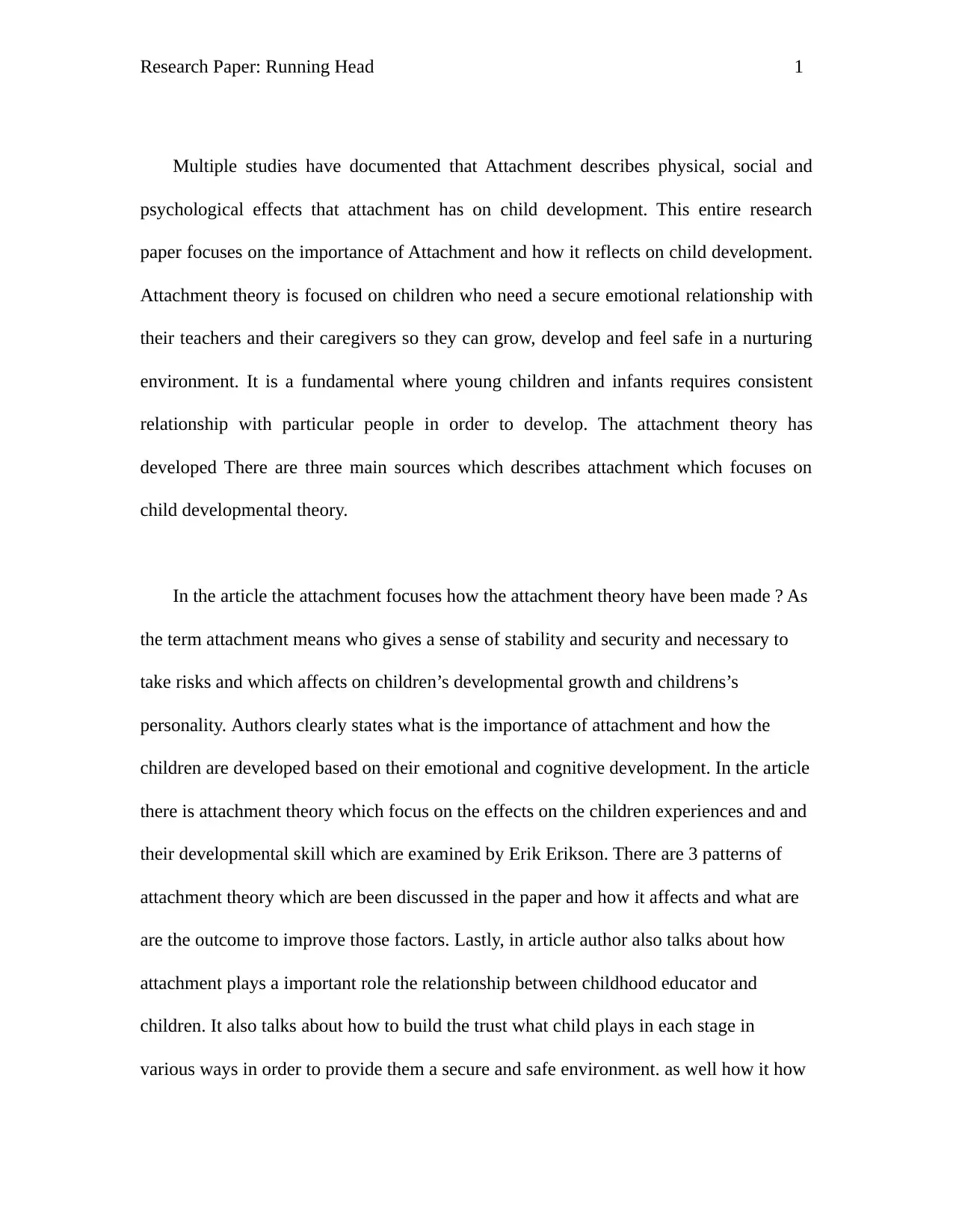
Research Paper: Running Head 1
Multiple studies have documented that Attachment describes physical, social and
psychological effects that attachment has on child development. This entire research
paper focuses on the importance of Attachment and how it reflects on child development.
Attachment theory is focused on children who need a secure emotional relationship with
their teachers and their caregivers so they can grow, develop and feel safe in a nurturing
environment. It is a fundamental where young children and infants requires consistent
relationship with particular people in order to develop. The attachment theory has
developed There are three main sources which describes attachment which focuses on
child developmental theory.
In the article the attachment focuses how the attachment theory have been made ? As
the term attachment means who gives a sense of stability and security and necessary to
take risks and which affects on children’s developmental growth and childrens’s
personality. Authors clearly states what is the importance of attachment and how the
children are developed based on their emotional and cognitive development. In the article
there is attachment theory which focus on the effects on the children experiences and and
their developmental skill which are examined by Erik Erikson. There are 3 patterns of
attachment theory which are been discussed in the paper and how it affects and what are
are the outcome to improve those factors. Lastly, in article author also talks about how
attachment plays a important role the relationship between childhood educator and
children. It also talks about how to build the trust what child plays in each stage in
various ways in order to provide them a secure and safe environment. as well how it how
Multiple studies have documented that Attachment describes physical, social and
psychological effects that attachment has on child development. This entire research
paper focuses on the importance of Attachment and how it reflects on child development.
Attachment theory is focused on children who need a secure emotional relationship with
their teachers and their caregivers so they can grow, develop and feel safe in a nurturing
environment. It is a fundamental where young children and infants requires consistent
relationship with particular people in order to develop. The attachment theory has
developed There are three main sources which describes attachment which focuses on
child developmental theory.
In the article the attachment focuses how the attachment theory have been made ? As
the term attachment means who gives a sense of stability and security and necessary to
take risks and which affects on children’s developmental growth and childrens’s
personality. Authors clearly states what is the importance of attachment and how the
children are developed based on their emotional and cognitive development. In the article
there is attachment theory which focus on the effects on the children experiences and and
their developmental skill which are examined by Erik Erikson. There are 3 patterns of
attachment theory which are been discussed in the paper and how it affects and what are
are the outcome to improve those factors. Lastly, in article author also talks about how
attachment plays a important role the relationship between childhood educator and
children. It also talks about how to build the trust what child plays in each stage in
various ways in order to provide them a secure and safe environment. as well how it how
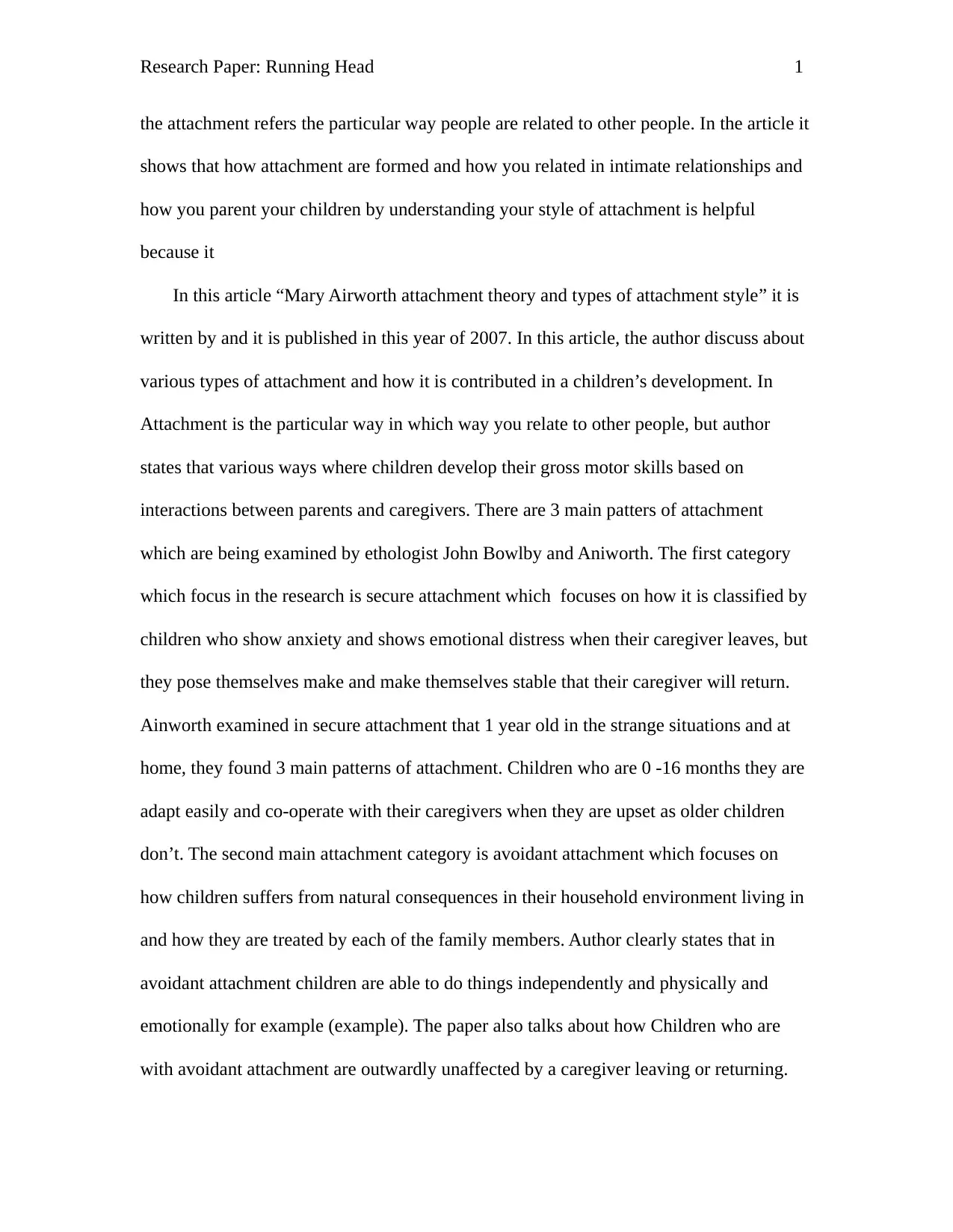
Research Paper: Running Head 1
the attachment refers the particular way people are related to other people. In the article it
shows that how attachment are formed and how you related in intimate relationships and
how you parent your children by understanding your style of attachment is helpful
because it
In this article “Mary Airworth attachment theory and types of attachment style” it is
written by and it is published in this year of 2007. In this article, the author discuss about
various types of attachment and how it is contributed in a children’s development. In
Attachment is the particular way in which way you relate to other people, but author
states that various ways where children develop their gross motor skills based on
interactions between parents and caregivers. There are 3 main patters of attachment
which are being examined by ethologist John Bowlby and Aniworth. The first category
which focus in the research is secure attachment which focuses on how it is classified by
children who show anxiety and shows emotional distress when their caregiver leaves, but
they pose themselves make and make themselves stable that their caregiver will return.
Ainworth examined in secure attachment that 1 year old in the strange situations and at
home, they found 3 main patterns of attachment. Children who are 0 -16 months they are
adapt easily and co-operate with their caregivers when they are upset as older children
don’t. The second main attachment category is avoidant attachment which focuses on
how children suffers from natural consequences in their household environment living in
and how they are treated by each of the family members. Author clearly states that in
avoidant attachment children are able to do things independently and physically and
emotionally for example (example). The paper also talks about how Children who are
with avoidant attachment are outwardly unaffected by a caregiver leaving or returning.
the attachment refers the particular way people are related to other people. In the article it
shows that how attachment are formed and how you related in intimate relationships and
how you parent your children by understanding your style of attachment is helpful
because it
In this article “Mary Airworth attachment theory and types of attachment style” it is
written by and it is published in this year of 2007. In this article, the author discuss about
various types of attachment and how it is contributed in a children’s development. In
Attachment is the particular way in which way you relate to other people, but author
states that various ways where children develop their gross motor skills based on
interactions between parents and caregivers. There are 3 main patters of attachment
which are being examined by ethologist John Bowlby and Aniworth. The first category
which focus in the research is secure attachment which focuses on how it is classified by
children who show anxiety and shows emotional distress when their caregiver leaves, but
they pose themselves make and make themselves stable that their caregiver will return.
Ainworth examined in secure attachment that 1 year old in the strange situations and at
home, they found 3 main patterns of attachment. Children who are 0 -16 months they are
adapt easily and co-operate with their caregivers when they are upset as older children
don’t. The second main attachment category is avoidant attachment which focuses on
how children suffers from natural consequences in their household environment living in
and how they are treated by each of the family members. Author clearly states that in
avoidant attachment children are able to do things independently and physically and
emotionally for example (example). The paper also talks about how Children who are
with avoidant attachment are outwardly unaffected by a caregiver leaving or returning.
⊘ This is a preview!⊘
Do you want full access?
Subscribe today to unlock all pages.

Trusted by 1+ million students worldwide
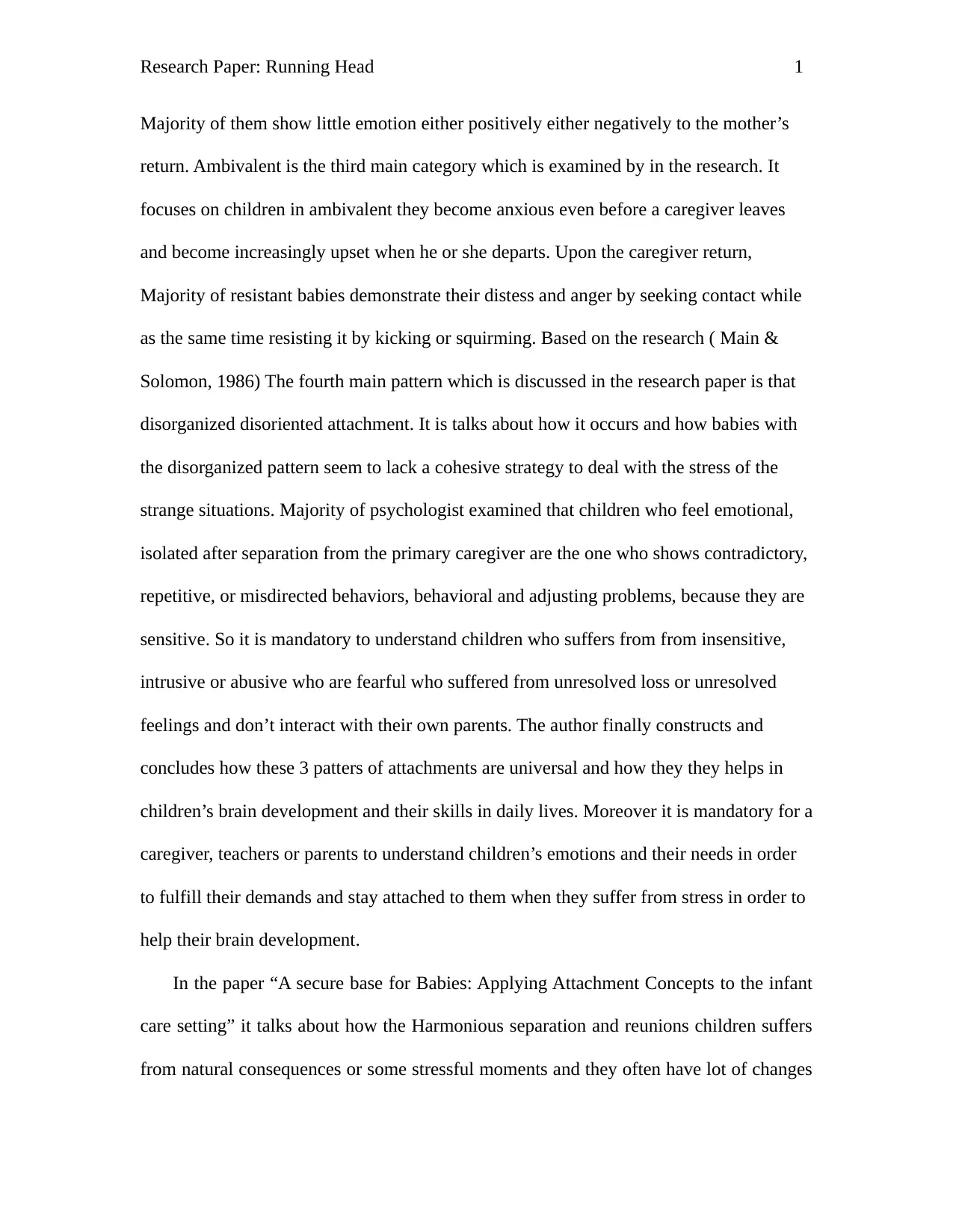
Research Paper: Running Head 1
Majority of them show little emotion either positively either negatively to the mother’s
return. Ambivalent is the third main category which is examined by in the research. It
focuses on children in ambivalent they become anxious even before a caregiver leaves
and become increasingly upset when he or she departs. Upon the caregiver return,
Majority of resistant babies demonstrate their distess and anger by seeking contact while
as the same time resisting it by kicking or squirming. Based on the research ( Main &
Solomon, 1986) The fourth main pattern which is discussed in the research paper is that
disorganized disoriented attachment. It is talks about how it occurs and how babies with
the disorganized pattern seem to lack a cohesive strategy to deal with the stress of the
strange situations. Majority of psychologist examined that children who feel emotional,
isolated after separation from the primary caregiver are the one who shows contradictory,
repetitive, or misdirected behaviors, behavioral and adjusting problems, because they are
sensitive. So it is mandatory to understand children who suffers from from insensitive,
intrusive or abusive who are fearful who suffered from unresolved loss or unresolved
feelings and don’t interact with their own parents. The author finally constructs and
concludes how these 3 patters of attachments are universal and how they they helps in
children’s brain development and their skills in daily lives. Moreover it is mandatory for a
caregiver, teachers or parents to understand children’s emotions and their needs in order
to fulfill their demands and stay attached to them when they suffer from stress in order to
help their brain development.
In the paper “A secure base for Babies: Applying Attachment Concepts to the infant
care setting” it talks about how the Harmonious separation and reunions children suffers
from natural consequences or some stressful moments and they often have lot of changes
Majority of them show little emotion either positively either negatively to the mother’s
return. Ambivalent is the third main category which is examined by in the research. It
focuses on children in ambivalent they become anxious even before a caregiver leaves
and become increasingly upset when he or she departs. Upon the caregiver return,
Majority of resistant babies demonstrate their distess and anger by seeking contact while
as the same time resisting it by kicking or squirming. Based on the research ( Main &
Solomon, 1986) The fourth main pattern which is discussed in the research paper is that
disorganized disoriented attachment. It is talks about how it occurs and how babies with
the disorganized pattern seem to lack a cohesive strategy to deal with the stress of the
strange situations. Majority of psychologist examined that children who feel emotional,
isolated after separation from the primary caregiver are the one who shows contradictory,
repetitive, or misdirected behaviors, behavioral and adjusting problems, because they are
sensitive. So it is mandatory to understand children who suffers from from insensitive,
intrusive or abusive who are fearful who suffered from unresolved loss or unresolved
feelings and don’t interact with their own parents. The author finally constructs and
concludes how these 3 patters of attachments are universal and how they they helps in
children’s brain development and their skills in daily lives. Moreover it is mandatory for a
caregiver, teachers or parents to understand children’s emotions and their needs in order
to fulfill their demands and stay attached to them when they suffer from stress in order to
help their brain development.
In the paper “A secure base for Babies: Applying Attachment Concepts to the infant
care setting” it talks about how the Harmonious separation and reunions children suffers
from natural consequences or some stressful moments and they often have lot of changes
Paraphrase This Document
Need a fresh take? Get an instant paraphrase of this document with our AI Paraphraser
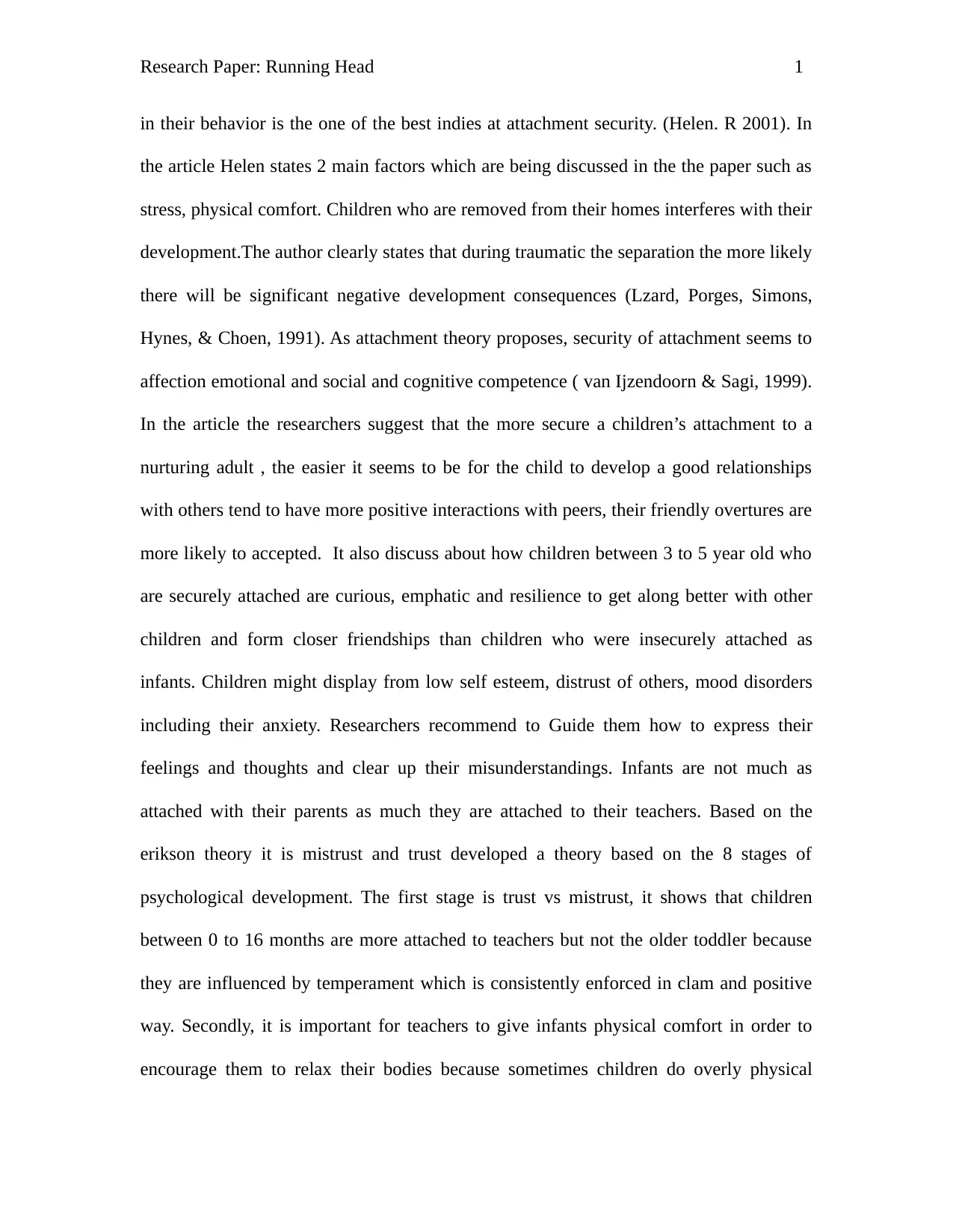
Research Paper: Running Head 1
in their behavior is the one of the best indies at attachment security. (Helen. R 2001). In
the article Helen states 2 main factors which are being discussed in the the paper such as
stress, physical comfort. Children who are removed from their homes interferes with their
development.The author clearly states that during traumatic the separation the more likely
there will be significant negative development consequences (Lzard, Porges, Simons,
Hynes, & Choen, 1991). As attachment theory proposes, security of attachment seems to
affection emotional and social and cognitive competence ( van Ijzendoorn & Sagi, 1999).
In the article the researchers suggest that the more secure a children’s attachment to a
nurturing adult , the easier it seems to be for the child to develop a good relationships
with others tend to have more positive interactions with peers, their friendly overtures are
more likely to accepted. It also discuss about how children between 3 to 5 year old who
are securely attached are curious, emphatic and resilience to get along better with other
children and form closer friendships than children who were insecurely attached as
infants. Children might display from low self esteem, distrust of others, mood disorders
including their anxiety. Researchers recommend to Guide them how to express their
feelings and thoughts and clear up their misunderstandings. Infants are not much as
attached with their parents as much they are attached to their teachers. Based on the
erikson theory it is mistrust and trust developed a theory based on the 8 stages of
psychological development. The first stage is trust vs mistrust, it shows that children
between 0 to 16 months are more attached to teachers but not the older toddler because
they are influenced by temperament which is consistently enforced in clam and positive
way. Secondly, it is important for teachers to give infants physical comfort in order to
encourage them to relax their bodies because sometimes children do overly physical
in their behavior is the one of the best indies at attachment security. (Helen. R 2001). In
the article Helen states 2 main factors which are being discussed in the the paper such as
stress, physical comfort. Children who are removed from their homes interferes with their
development.The author clearly states that during traumatic the separation the more likely
there will be significant negative development consequences (Lzard, Porges, Simons,
Hynes, & Choen, 1991). As attachment theory proposes, security of attachment seems to
affection emotional and social and cognitive competence ( van Ijzendoorn & Sagi, 1999).
In the article the researchers suggest that the more secure a children’s attachment to a
nurturing adult , the easier it seems to be for the child to develop a good relationships
with others tend to have more positive interactions with peers, their friendly overtures are
more likely to accepted. It also discuss about how children between 3 to 5 year old who
are securely attached are curious, emphatic and resilience to get along better with other
children and form closer friendships than children who were insecurely attached as
infants. Children might display from low self esteem, distrust of others, mood disorders
including their anxiety. Researchers recommend to Guide them how to express their
feelings and thoughts and clear up their misunderstandings. Infants are not much as
attached with their parents as much they are attached to their teachers. Based on the
erikson theory it is mistrust and trust developed a theory based on the 8 stages of
psychological development. The first stage is trust vs mistrust, it shows that children
between 0 to 16 months are more attached to teachers but not the older toddler because
they are influenced by temperament which is consistently enforced in clam and positive
way. Secondly, it is important for teachers to give infants physical comfort in order to
encourage them to relax their bodies because sometimes children do overly physical
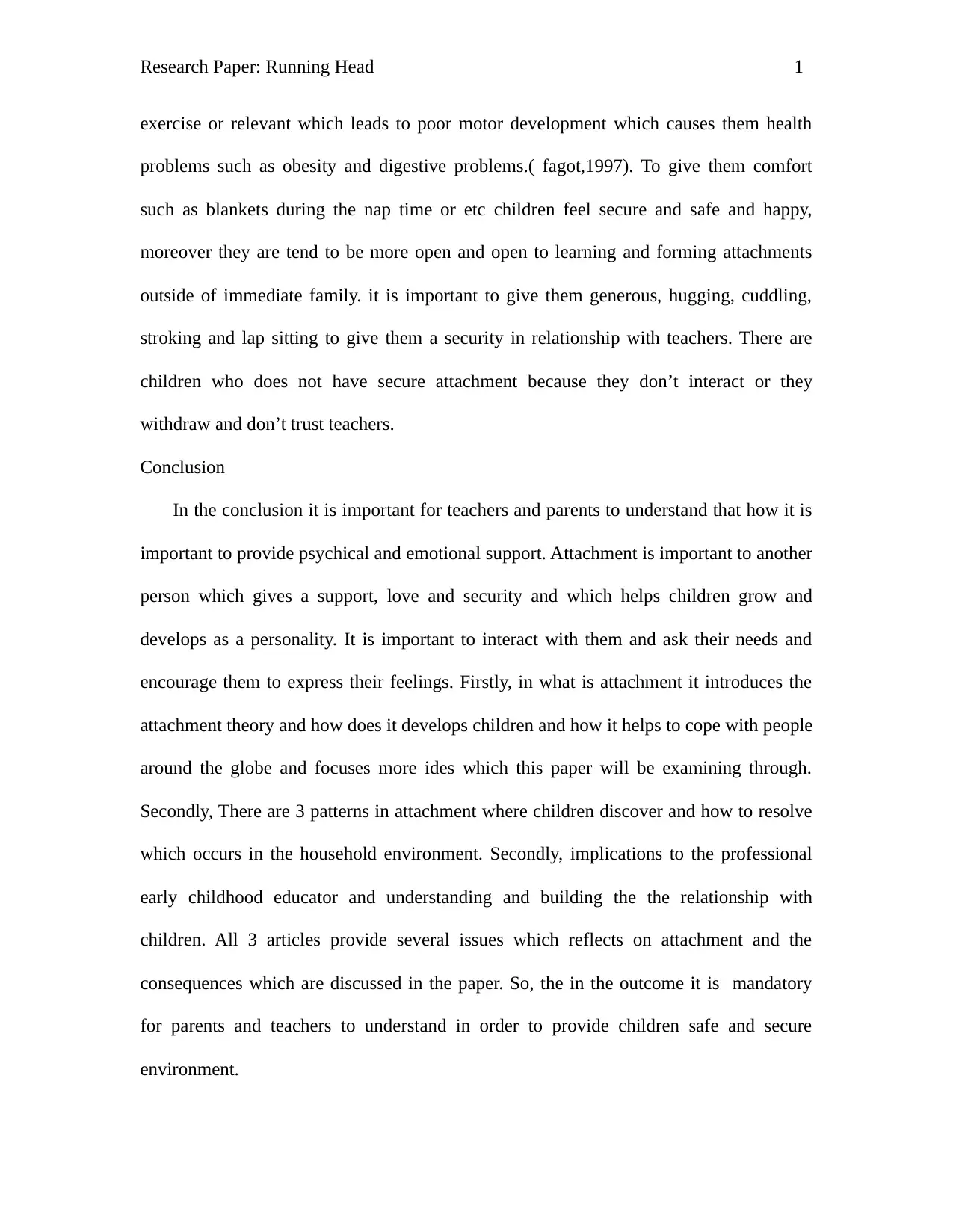
Research Paper: Running Head 1
exercise or relevant which leads to poor motor development which causes them health
problems such as obesity and digestive problems.( fagot,1997). To give them comfort
such as blankets during the nap time or etc children feel secure and safe and happy,
moreover they are tend to be more open and open to learning and forming attachments
outside of immediate family. it is important to give them generous, hugging, cuddling,
stroking and lap sitting to give them a security in relationship with teachers. There are
children who does not have secure attachment because they don’t interact or they
withdraw and don’t trust teachers.
Conclusion
In the conclusion it is important for teachers and parents to understand that how it is
important to provide psychical and emotional support. Attachment is important to another
person which gives a support, love and security and which helps children grow and
develops as a personality. It is important to interact with them and ask their needs and
encourage them to express their feelings. Firstly, in what is attachment it introduces the
attachment theory and how does it develops children and how it helps to cope with people
around the globe and focuses more ides which this paper will be examining through.
Secondly, There are 3 patterns in attachment where children discover and how to resolve
which occurs in the household environment. Secondly, implications to the professional
early childhood educator and understanding and building the the relationship with
children. All 3 articles provide several issues which reflects on attachment and the
consequences which are discussed in the paper. So, the in the outcome it is mandatory
for parents and teachers to understand in order to provide children safe and secure
environment.
exercise or relevant which leads to poor motor development which causes them health
problems such as obesity and digestive problems.( fagot,1997). To give them comfort
such as blankets during the nap time or etc children feel secure and safe and happy,
moreover they are tend to be more open and open to learning and forming attachments
outside of immediate family. it is important to give them generous, hugging, cuddling,
stroking and lap sitting to give them a security in relationship with teachers. There are
children who does not have secure attachment because they don’t interact or they
withdraw and don’t trust teachers.
Conclusion
In the conclusion it is important for teachers and parents to understand that how it is
important to provide psychical and emotional support. Attachment is important to another
person which gives a support, love and security and which helps children grow and
develops as a personality. It is important to interact with them and ask their needs and
encourage them to express their feelings. Firstly, in what is attachment it introduces the
attachment theory and how does it develops children and how it helps to cope with people
around the globe and focuses more ides which this paper will be examining through.
Secondly, There are 3 patterns in attachment where children discover and how to resolve
which occurs in the household environment. Secondly, implications to the professional
early childhood educator and understanding and building the the relationship with
children. All 3 articles provide several issues which reflects on attachment and the
consequences which are discussed in the paper. So, the in the outcome it is mandatory
for parents and teachers to understand in order to provide children safe and secure
environment.
⊘ This is a preview!⊘
Do you want full access?
Subscribe today to unlock all pages.

Trusted by 1+ million students worldwide
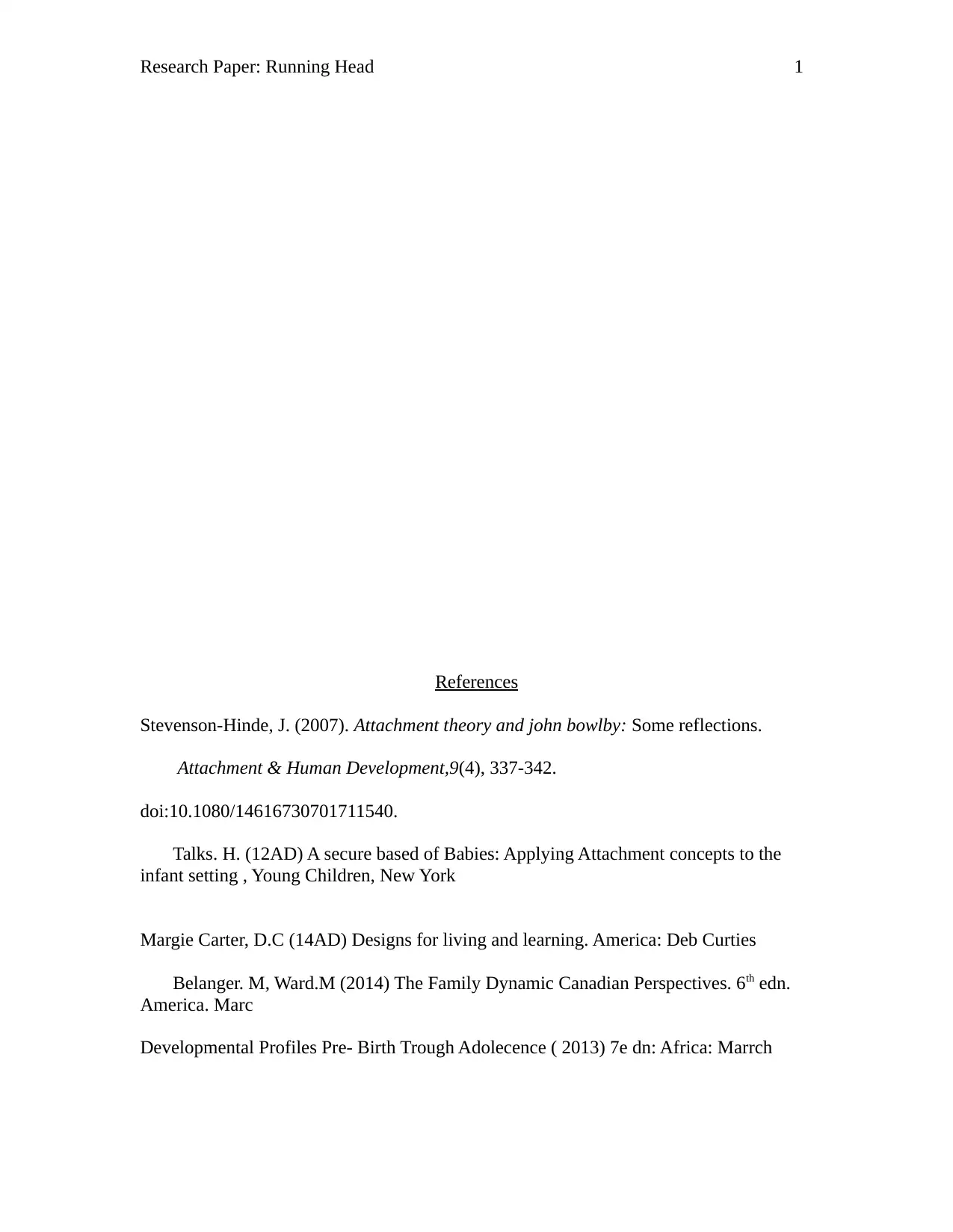
Research Paper: Running Head 1
References
Stevenson-Hinde, J. (2007). Attachment theory and john bowlby: Some reflections.
Attachment & Human Development,9(4), 337-342.
doi:10.1080/14616730701711540.
Talks. H. (12AD) A secure based of Babies: Applying Attachment concepts to the
infant setting , Young Children, New York
Margie Carter, D.C (14AD) Designs for living and learning. America: Deb Curties
Belanger. M, Ward.M (2014) The Family Dynamic Canadian Perspectives. 6th edn.
America. Marc
Developmental Profiles Pre- Birth Trough Adolecence ( 2013) 7e dn: Africa: Marrch
References
Stevenson-Hinde, J. (2007). Attachment theory and john bowlby: Some reflections.
Attachment & Human Development,9(4), 337-342.
doi:10.1080/14616730701711540.
Talks. H. (12AD) A secure based of Babies: Applying Attachment concepts to the
infant setting , Young Children, New York
Margie Carter, D.C (14AD) Designs for living and learning. America: Deb Curties
Belanger. M, Ward.M (2014) The Family Dynamic Canadian Perspectives. 6th edn.
America. Marc
Developmental Profiles Pre- Birth Trough Adolecence ( 2013) 7e dn: Africa: Marrch
Paraphrase This Document
Need a fresh take? Get an instant paraphrase of this document with our AI Paraphraser
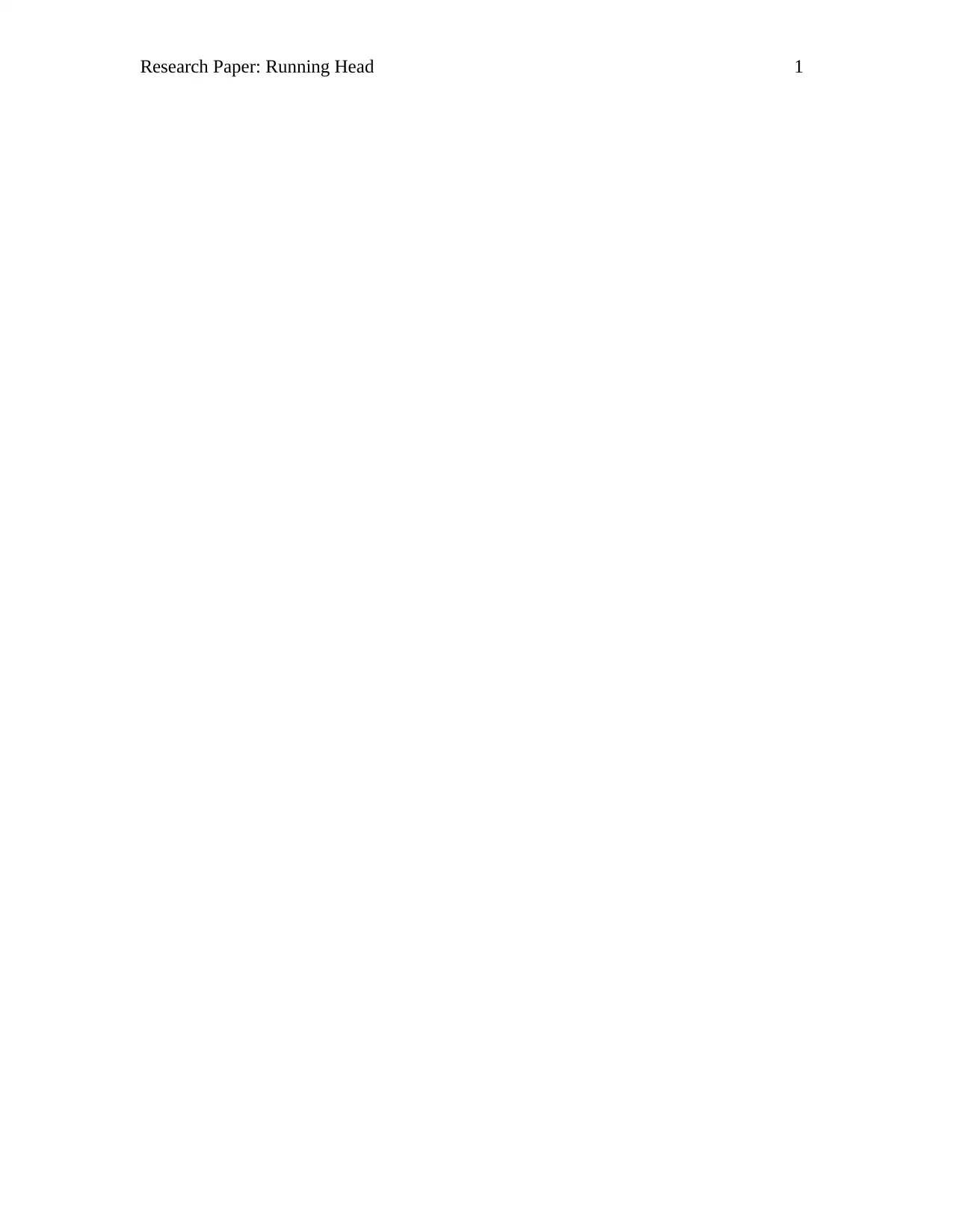
Research Paper: Running Head 1
1 out of 8
Related Documents
Your All-in-One AI-Powered Toolkit for Academic Success.
+13062052269
info@desklib.com
Available 24*7 on WhatsApp / Email
![[object Object]](/_next/static/media/star-bottom.7253800d.svg)
Unlock your academic potential
Copyright © 2020–2025 A2Z Services. All Rights Reserved. Developed and managed by ZUCOL.





